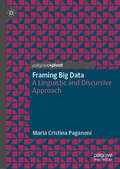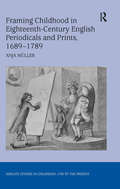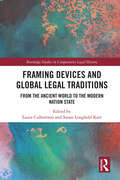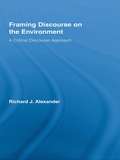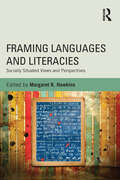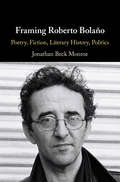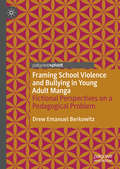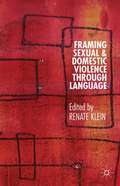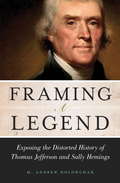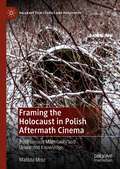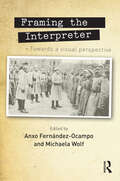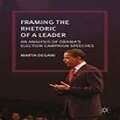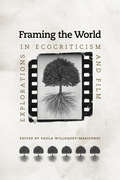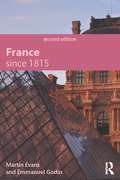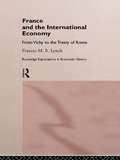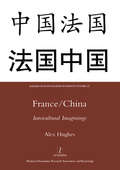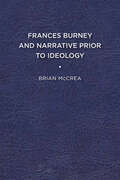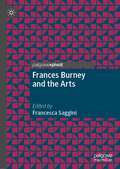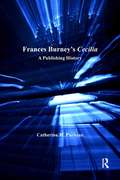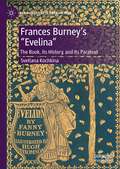- Table View
- List View
Framing Big Data: A Linguistic and Discursive Approach
by Maria Cristina PaganoniThis book addresses big data as a socio-technical construct with huge potential for innovation in key sectors such as healthcare, government and business. Big data and its increasingly widespread use in such influential spheres can generate ethically controversial decisions, including questions surrounding privacy, consent and accountability. This book attempts to unpack the epistemological implications of the term ‘big data’, as well as the opportunities and responsibilities which come with it. The author analyses the linguistic texture of the big data narrative in the news media, in healthcare and in EU law on data protection, in order to contribute to its understanding from the critical perspective of language studies. The result is a study which will be of interest to students and scholars working in the digital humanities, corpus linguistics, and discourse studies.
Framing Childhood in Eighteenth-Century English Periodicals and Prints, 1689–1789 (Studies in Childhood, 1700 to the Present)
by Anja MüllerShedding light on an important and neglected topic in childhood studies, Anja Müller interrogates how different concepts of childhood proliferated and were construed in several important eighteenth-century periodicals and satirical prints. Müller focuses on The Tatler, The Spectator, The Guardian, The Female Tatler, and The Female Spectator, arguing that these periodicals contributed significantly to the construction, development, and popularization of childhood concepts that provided the basis for later ideas such as the 'Romantic child'. Informed by the theoretical concept of 'framing', by which certain concepts of childhood are accepted as legitimate while others are excluded, Framing Childhood analyses the textual and graphic constructions of the child's body, educational debates, how the shift from genealogical to affective bonding affected conceptions of parent-child relations, and how prints employed child figures as focalizers in their representations of public scenes. In examining links between text and image, Müller uncovers the role these media played in the genealogy of childhood before the 1790s, offering a re-visioning of the myth that situates the origin of childhood in late eighteenth-century England.
Framing Devices and Global Legal Traditions: From the Ancient World to the Modern Nation State (Routledge Studies in Comparative Legal History)
by Laura Culbertson Susan Longfield KarrThis collection explores prefaces, prologues, paratexts, and other types of framing devices. Across world history, these devices have introduced the law, articulated its context and audience, identified the basis of legal and moral authority, critiqued existing conditions, or even tried to "restore" something that never was. Scribes, lawmakers, and legal theorists also used frames to position the law in time and space, purporting to define populations and their identities. Despite the ubiquity and complexity of these phenomena, few studies have drawn out methods for studying their role in constructing, fortifying, or reimagining legal frameworks within legal cultures or traditions. This volume offers new ways to consider the significance of framing apparatuses regarding how and why they are created, remembered, forgotten, utilized, and recovered within legal traditions. The studies range from the ancient world to the modern nation-state system, aiming to explore the intersections and collisions between juridical and political interpretation practices.The book will be of interest to academics and researchers in the areas of legal history, comparative law, legal cultures and traditions, legal theory, jurisprudence, constitutional law and legislative drafting.
Framing Discourse on the Environment: A Critical Discourse Approach (Routledge Critical Studies in Discourse)
by Richard AlexanderIn this study, Richard Alexander presents a series of original and empirically based case studies of the language and discourse involved in the discussion of environmental and ecological issues. Relying upon a variety of different text types and genres – including company websites, advertisements, press articles, speeches and lectures – Alexander interrogates how in the media, press, corporate and activist circles language is employed to argue for and propagate selected positions on the growing ecological crisis. For example, he asks: How are ecological and environmental concerns articulated in texts? What do we learn about ecological ‘problems’ through texts from differing sources? What language features accompany ecological discourse in differing contexts and registers? Attention is especially directed at where this discourse comes into contact with business, economic and political concerns.
Framing Languages and Literacies: Socially Situated Views and Perspectives
by Margaret R. HawkinsIn this seminal volume leading language and literacy scholars clearly articulate and explicate major social perspectives and approaches in the fields of language and literacy studies. Each approach draws on distinct bodies of literature and traditions and uses distinct identifiers, labels, and constellations of concepts; each has been taken up across diverse global contexts and is used as rationale and guide for the design of research and of educational policies and practices. Authors discuss the genesis and historical trajectory of the approach with which they are associated; offer their unique perspectives, rationales, and engagements; and investigate implications for understanding language and literacy use in and out of schools. The premise of the book is that understanding concepts, perspectives, and approaches requires knowing the context in which they were created, the rationale or purpose in creating them, and how they have been taken up and applied in communities of practice. Accessible yet theoretically rich, this volume is indispensible for researchers, students, and professionals across the fields of language and literacy studies.
Framing Public Life: Perspectives on Media and Our Understanding of the Social World (Routledge Communication Series)
by Jr. August E. Grant Stephen D. Reese Oscar H. GandyThis distinctive volume offers a thorough examination of the ways in which meaning comes to be shaped. Editors Stephen Reese, Oscar Gandy, and August Grant employ an interdisciplinary approach to the study of conceptualizing and examining media. They illustrate how texts and those who provide them powerfully shape, or "frame," our social worlds and thus affect our public life. Embracing qualitative and quantitative, visual and verbal, and psychological and sociological perspectives, this book helps media consumers develop a multi-faceted understanding of media power, especially in the realm of news and public affairs.
Framing Roberto Bolaño: Poetry, Fiction, Literary History, Politics
by Jonathan Beck MonroePoetry, fiction, literary history, and politics. These four cornerstone concerns of Roberto Bolaño's work have established him as a representative, generational figure in not only Chile, Mexico, and Spain, the three principal locations of his life and work, but throughout Europe and the Americas, increasingly on a global scale. At the heart of Bolaño's 'poemas-novela', his poet- and poetry-centered novels, is the history and legacy of the prose poem. Challenging the policing of boundaries between verse and prose, poetry and fiction, the literary and the non-literary, the aesthetic and the political, his prose poem novels offer a sustained literary history by other means, a pivotal intervention that restores poetry and literature to full capacity. Framing Roberto Bolaño is one of the first books to trace the full arc and development of Bolaño's work from the beginning to the end of his career.
Framing School Violence and Bullying in Young Adult Manga: Fictional Perspectives on a Pedagogical Problem
by Drew Emanuel BerkowitzThis book closely examines the ways in which many popular, internationally-published Japanese young adult manga graphic novel titles frame instances of K-12 school-situated violence and bullying. Manga is a Japanese literary medium that has grown worldwide as an increasingly visible fixture of young adults’ recreational reading habits. The author uncovers the medium’s most prevalent patterns of defining, depicting, and discussing school-situated violence and bullying. Through the lens of socio-cultural media frame analysis, he explores what these patterns might indicate about young adults' preexisting views and beliefs about occurrences of violence and bullying within their own school environments. This in-depth investigation of manga literature provides important information pertaining to the pedagogies and practices of K-12 teachers and school administrators, as well as detailed advice for parents of young adult manga fans.
Framing Sexual and Domestic Violence through Language
by Renate KleinWith examples from throughout Europe and the United States, the contributors to this volume explore how gender violence is framed through language and what this means for research and policy. Language shapes responses to abuse and approaches to perpetrators and interfaces with national debates about gender, violence, and social change.
Framing Sustainability in Language and Communication (Routledge Research in Language and Communication)
by Maida Kosatica Sean P. SmithThis collection brings together established and emerging scholars for a critical framing of sustainability through the lens of language and communication, social semiotics, and media studies. The volume underscores the importance of re-envisioning sustainability around not only climate change and biodiversity loss but in broader systems of ecological, social, and economic imbalances on a global scale.The book begins with a visual essay which provides a semiotic foundation for understandings of sustainability across disciplinary approaches in the chapters that follow. Subsequent chapters are organized around four thematic parts: reframing sustainability in a colonial world; the semiotics of sustainability; communicating sustainability in everyday life; and sustainability communication in the arts. A closing commentary by Crispin Thurlow offers critical reflections on sustainability within language and communication research and beyond.This book will be of interest to scholars addressing sustainability across diverse disciplines, including language and communication, social semiotics, linguistic anthropology, environmental communication, media studies, and development studies.
Framing a Legend
by M. Andrew HolowchakA penetrating critical perspective on the question of Thomas Jefferson's paternity that will make you rethink recent conventional wisdom. It is accepted by most scholars that Jefferson had a lengthy affair with his slave Sally Hemings and fathered at least one of her children, a conclusion based on a 1998 DNA study published in Nature and on the work of historian Annette Gordon-Reed. Framing a Legend argues compellingly that the DNA evidence is inconclusive and that there are remarkable flaws in the leading historical scholarship purporting to show such a liaison. It critically examines well-known books by Fawn Brodie, Annette Gordon-Reed, and Andrew Burstein. Among other defects in these authors' works, Holowchak notes selective use of evidence, ungrounded speculation, tendentious psychologizing, and unpersuasive argumentation. He delves into what we know about Thomas Jefferson's character by showing that the historical facts do not suggest any romantic interest on Jefferson's part in his female slaves. Turning to the genetic evidence, Holowchak points out that, though DNA analysis indicates the presence of a Y-chromosome from some Jefferson male in the Hemings family line, it is unwarranted to conclude that this must have come from Thomas Jefferson. Finally, he discusses Jefferson's racial attitudes and says that they argue against any liaison with Sally Hemings.
Framing the Holocaust in Polish Aftermath Cinema: Posthumous Materiality and Unwanted Knowledge (Palgrave Film Studies and Philosophy)
by Matilda MrozThis book offers a unique perspective on contemporary Polish cinema’s engagement with histories of Polish violence against their Jewish neighbours during the Holocaust. Moving beyond conventional studies of historical representation on screen, the book considers how cinema reframes the unwanted knowledge of violence in its aftermaths. The book draws on Derridean hauntology, Didi-Huberman’s confrontations with art images, Levinasian ethics and anamorphosis to examine cinematic reconfigurations of histories and memories that are vulnerable to evasion and formlessness. Innovative analyses of Birthplace (Łoziński, 1992), It Looks Pretty From a Distance (Sasnal, 2011), Aftermath (Pasikowski, 2012), and Ida (Pawlikowski, 2013) explore how their rural filmic landscapes are predicated on the radical exclusion of Jewish neighbours, prompting archaeological processes of exhumation. Arguing that the distressing materiality of decomposition disturbs cinematic composition, the book examines how Poland’s aftermath cinema attempts to recompose itself through form and narrative as it faces Polish complicity in Jewish death.
Framing the Interpreter: Towards a visual perspective
by Michaela Wolf Anxo Fernandez-OcampoSituations of conflict offer special insights into the history of the interpreter figure, and specifically the part played in that history by photographic representations of interpreters. This book analyses photo postcards, snapshots and press photos from several historical periods of conflict, associated with different photographic technologies and habits of image consumption: the colonial period, the First and Second World War, and the Cold War. The book’s methodological approach to the "framing" of the interpreter uses tools taken primarily from visual anthropology, sociology and visual syntax to analyse the imagery of the modern era of interpreting. By means of these interpretative frames, the contributions suggest that each culture, subculture or social group constructed its own representation of the interpreter figure through photography. The volume breaks new ground for image-based research in translation studies by examining photographic representations that reveal the interpreter as a socially constructed category. It locates the interpreter’s mediating efforts at the core of the human sciences. This book will be of interest to researchers and advanced students in translation and interpreting studies, as well as to those working in visual studies, photography, anthropology and military/conflict studies.
Framing the Rhetoric of a Leader
by Marta DeganiBased on a selection of 30 election campaign speeches during Obama's first run for the American presidency in 2008, this book investigates the Democratic presidential candidate's much celebrated rhetoric from a cognitive semantics point of view.
Framing the Rhetoric of a Leader: An Analysis of Obama’s Election Campaign Speeches
by M. DeganiBased on a selection of 30 election campaign speeches during Obama's first run for the American presidency in 2008, this book investigates the Democratic presidential candidate's much celebrated rhetoric from a cognitive semantics point of view.
Framing the World: Explorations in Ecocriticism and Film (Under the Sign of Nature: Explorations in Ecocriticism)
by Paula Willoquet-MaricondiThe essays in this collection make a contribution to the greening of film studies and expand the scope of ecocriticism as a discipline traditionally rooted in literary studies. In addition to highlighting particular films as productive tools for raising awareness and educating us about environmental issues, Framing the World: Explorations in Ecocriticism and Film encourages its readers to become more ecologically minded viewers, sensitive to the ways in which films reflect, shape, reinforce, and challenge our perceptions of nature, of human/nature relations, and of environmental issues. The contributors to this volume offer in-depth analyses of a broad range of films, including fictional and documentary, Hollywood and independent, domestic and foreign, experimental and indigenous. Drawing from disciplines including film theory, ecocriticism, philosophy, rhetoric, environmental justice, and American and Indigenous studies, Framing the World offers new and original approaches to the ecocritical study of cinema. The twelve essays are gathered in four parts, focusing on ecocinema as activist cinema; the representation of environmental justice issues in Hollywood, independent, and foreign films; the representation of animals, ecosystems, and natural and human-made landscapes in live action and animation; and ecological themes in the films of two eco-auteurs, Kiyoshi Kurosawa and Peter Greenaway. Willoquet-Maricondi's introduction provides an overview of the field of ecocriticism and offers both philosophical and theoretical foundations for the ecocritical study of films.ContributorsBeth Berila, St. Cloud State University * Lynne Dickson Bruckner, Chatham College * Elizabeth Henry, University of Denver * Joseph K. Heumann, Eastern Illinois University * Harri Kilpi, University of East Anglia * Jennifer Machiorlatti, Western Michigan University * Mark Minster, Rose-Hulman Institute of Technology * Robin L. Murray, Eastern Illinois University * Tim Palmer, University of North Carolina, Wilmington * Cory Shaman, Arkansas Tech University * Rachel Stein, Siena College * Paula Willoquet-Maricondi, Marist College
Fran Grabs It: Buildup Unit 3 Lap Book (Buildup Ser.)
by Sara Palacios Cindy Peattie Martin AkersNIMAC-sourced textbook
France Since 1815, Second Edition
by Martin Evans Emmanuel GodinPart of the Modern History for Modern Languages Series France since 1815 provides an accessible overview of the major socio-political changes in France during this period. Designed for area studies students studying French, it presents the historical context necessary for language students to understand the complexities of contemporary French society. Adopting a chronological approach, it surveys nearly two hundred years of French history, with events covered including The French Revolution, The Bourbon Restoration, The Third Republic, Occupied France, The Fourth Republic, The Gaullist Revolution and France after 2003. This revised edition includes new material that focuses on Chirac's second mandate (Iraq war, religion, suburbs and the inability/impossibility of carrying on with reform), an assessment of the controversial Sarkozy presidency, and a final chapter covering the last ten years, culminating in the results of the French presidential elections in 2012. Features include: clear timelines of main events and suggested topics for discussion glossary inserts throughout of key terms and concepts the use of primary documents to re-create and understand the past free access to a website (http://www.port.ac.uk/special/france1815to2003/) containing a wealth of complementary material Drawing on the best scholarship, particular emphasis has been given to the role of political memory, the contribution of women and the impact of colonialism and post-colonialism. The relationship between France and her European partners is analysed in greater depth and there are new sections explicitly situating France and the French within a wider transnational/global perspective.
France and the International Economy: From Vichy to the Treaty of Rome (Routledge Explorations in Economic History)
by Frances LynchThis is a comprehensive history of a critically formative period in French economic history. Frances Lynch covers topics such as the post-war negotiations for American aid, the reconstruction of a capital market, the modernization of French agriculture, the liberalization of trade in the 1950s and subsequent economic growth.
France/China: Intercultural Imaginings
by Alex HughesChina has long been an object of fascination for the French, who celebrated theirannee de la Chine in 2004. Symptomatic of that fascination are the movements into China made by groups as diverse as the Jesuits, who arrived inL'Empire du Milieu in the late seventeenth century, and theTel Quel intellectuals, whose will to political pilgrimage took th
Frances Burney and Narrative Prior to Ideology
by Brian McCreaFrances Burney and Narrative Prior to Ideology works between Burney’s Journals and Letters and her fiction more thoroughly than any study of her in the past twenty-five years. By doing so, it offers significant reinterpretations of Burney’s four novels: Evelina, Cecilia, Camilla, and The Wanderer. It describes Burney’s eluding the major modern–isms through which critics have tried to read her: Feminism (with its “gendering” of beauty and reversal of gender roles); Capitalism and its Marxist critique (here the details of Burney’s housekeeping become important); Professionalism (as a response to status inconsistency and class conflict); and Ian Watt’s “Formal Realism” (Burney perhaps saved the novel from a sharp decline it suffered in the 1770s, even as she tried to distance herself from the genre). Burney’s most successful writing appeared before the coining of “ideology.” But her standing “prior to ideology” is not a matter of chronological accident. Rather, she quietly but forcefully resisted shared explanations—domesticity as model for household management, debt as basis for family finance, professional status as a means to social confidence, the novel as the dominant literary genre—that became popular during her long and eventful life. Frederic Jameson has described Paul de Man, “in private conversation,” claiming, “Marxism . . . has no way of understanding the eighteenth century.” Frances Burney and Narrative Prior to Ideology conjoins Burney’s “eighteenth-centuryness” with her modernity. Published by University of Delaware Press. Distributed worldwide by Rutgers University Press.
Frances Burney and the Arts: Frances Burney And The Theater Arts
by Francesca SagginiThis collection of essays by leading scholars in Burney studies provides an innovative, interdisciplinary critical consideration of the relationship of one of the major authors of the long English Romantic period with the arts. The encounter was not devoid of tensions and indeed often required a degree of wrangling on Burney’s part. This was a revealing and at times contentious dialogue, allowing us to reconstruct in an original and highly focused way the feminine negotiation with such key concepts of the late Enlightenment and Romanticism as virtue, reputation, creativity, originality, artistic expression, and self-construction. While there is now a flourishing body of work on Frances Burney and, more broadly, Romantic women authors, this book concentrates for the first time on the rich artistic and material context that surrounded, supported, and shaped Frances Burney’s oeuvre.
Frances Burney and the Doctors: Patient Narratives Then and Now
by John WiltshireFrances Burney is primarily known as a novelist and playwright, but in recent years there has been an increased interest in the medical writings found within her private letters and journals. John Wiltshire advocates Burney as the unconscious pioneer of the modern genre of pathography, or the illness narrative. Through her dramatic accounts of distinct medical events, such as her own infamous operation without anaesthetic, to those she witnessed, including the 'madness' of George III and the inoculation of her son against smallpox, Burney exposes the ethical issues and conflicts between patients and doctors. Her accounts are linked to a range of modern narratives in which similar events occur in the changed conditions of the public hospital. The genre that Burney initiated continues to make an important contribution to our understanding of medical practice in the modern world.
Frances Burney's Cecilia: A Publishing History (Ashgate Studies In Publishing History: Manuscript, Print, Digital Ser.)
by Catherine M. ParisianIn her exhaustive publishing history of Frances Burney's Cecilia, Or Memoirs of an Heiress, Catherine Parisian mines an extensive archival record that includes portions of the original manuscript, annotated page proofs, legal records relative to its copyright, and an abundance of letters, to chronicle the novel's composition, printing, and publication from its first edition in 1782 to the present-day Oxford World's Classics paperback. Generally regarded on its publication as the most important novel since Tobias Smollett's Humphrey Clinker, Cecilia is a deft blend of the satire of Henry Fielding with the sentimentality of Samuel Richardson that brings a female perspective to the novel while perceptively probing class and gender relations in eighteenth-century British society. Parisian combines the methods of the book historian with those of the bibliographer to show how the two usefully inform one another and bear on the interpretation of the literary text. Examining 51 different editions of Cecilia, Parisian considers what these editions reveal about Cecilia's reading audiences and what insights these books provide into the printing and publishing trends of the past 200 years. Lavishly illustrated and accessibly written, her timely history demonstrates the importance of Cecilia to the art of the novel and the history of the book.
Frances Burney’s “Evelina”: The Book, its History, and its Paratext (New Directions in Book History)
by Svetlana KochkinaEvelina, the first novel by Frances Burney, published in 1778, enjoys lasting popularity among the reading public. Tracing its publication history through 174 editions, adaptations, and reprints, many of them newly discovered and identified, this book demonstrates how the novel’s material embodiment in the form of the printed book has been reshaped by its publishers, recasting its content for new generations of readers. Four main chapters vividly describe how during 240 years, Evelina, a popular novel of manners, metamorphosed without any significant alterations to its text into a Regency “rambling” text, a romantic novel for “lecteurs délicats,” a cheap imprint for circulating libraries, a yellow-back, a book with a certain aesthetic cachet, a Christmas gift-book, finally becoming an integral part of the established literary canon in annotated scholarly editions. This book also focuses on the remodelling and transformation of the paratext in this novel, written by a woman author, by the heavily male-dominated publishing industry. Shorter Entr’acte sections discuss and describe alterations in the forms of Burney’s name and the title of her work, the omission and renaming of her authorial prefaces, and the redeployment of the publisher’s prefatorial apparatus to support particular editions throughout almost two-and-a-half centuries of the novel’s existence. Illustrated with reproductions of covers, frontispieces, and title pages, the book also provides an illuminating insight into the role of Evelina’s visual representation in its history as a marketable commodity, highlighting the existence of editions targeting various segments of the book market: from the upper-middle-class to mass-readership. The first comprehensive and fully updated bibliography of English and translated editions, adaptations, and reprints of Evelina published in 13 languages and scripts appears in an appendix.
